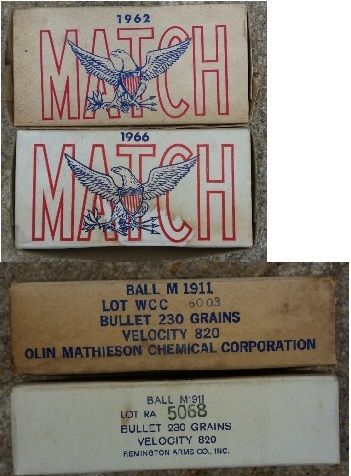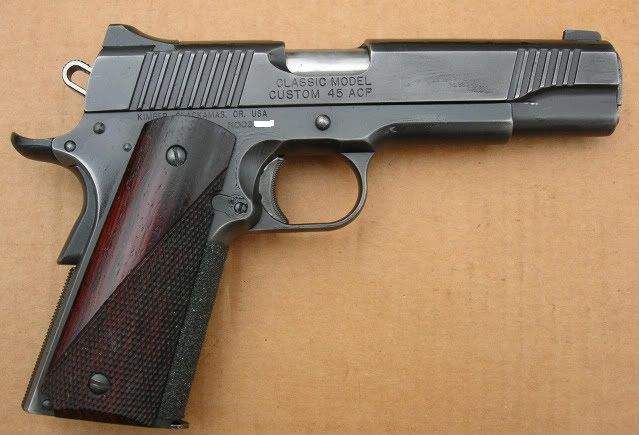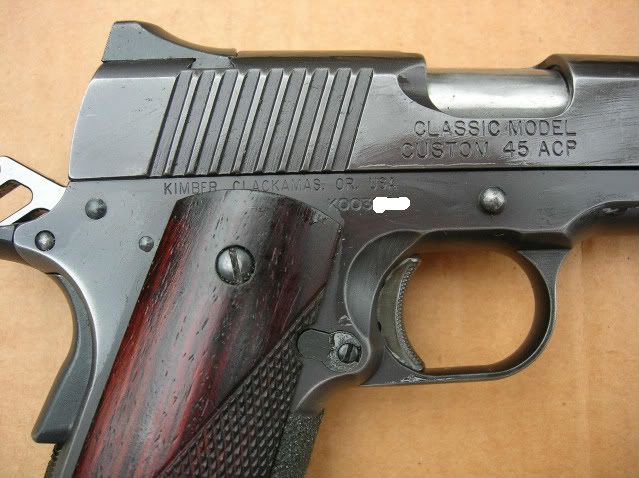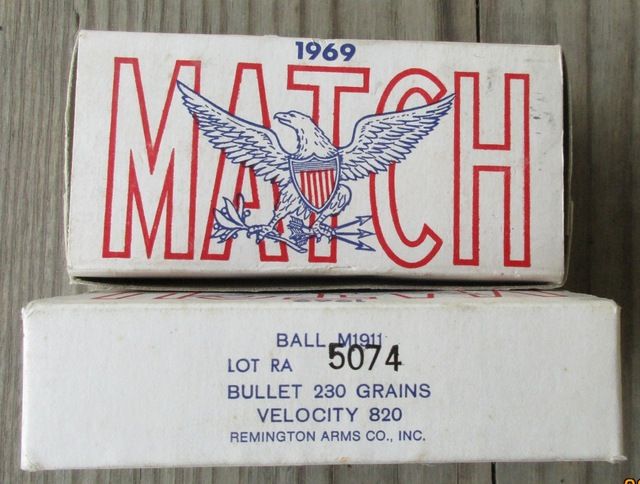
 |
|
|||||||
| Forum Rules | Firearms Safety | Firearms Photos | Links | Library | Lost Password | Email Changes |
| Register | FAQ | Calendar | Today's Posts | Search |
 |
|
|
Thread Tools | Search this Thread |
|
|
#1 |
|
Senior Member
Join Date: September 9, 2008
Location: New England,Florida Snow Bird
Posts: 312
|
USGI Service Load for the 1911A1?
I want to load up some 230 gr FMJ to USGI service load velocity. Some books say 830 fps, some say 860 fps. I think originally it was with a 200 gr FMJ at 900 fps. Can someone fill in the blanks. I'll probably use Bullseye. Thanks.
|
|
|
|
|
#2 |
|
Senior Member
Join Date: December 10, 2014
Posts: 1,965
|
It was 850 fps and a 230 gr. FMJ
|
|
|
|
|
#3 |
|
Staff
Join Date: March 11, 2006
Location: Upper US
Posts: 28,832
|
The closest I have to the GI specs is this,
Cartridge, Caliber .45, Ball, 1911 Velocity: 855fps +/- 25fps at 25.5 feet Pressure: 19,000psi, max avg Accuracy: 7.46" diagonal (max avg) at 50 yards Cartridge: 311-17gr Case: 87 -10 gr Bullet: 234-6gr copper alloy. 231gr guilding metal clad steel Propellant: SR7970, single base, flake, 5gr. HPC-1, double base, flake, 5grs, Point identification: Plain Tip Hope this helps.
__________________
All else being equal (and it almost never is) bigger bullets tend to work better. |
|
|
|
|
#4 |
|
Senior Member
Join Date: February 13, 2002
Location: Canada
Posts: 12,453
|
Once the dust settled from all the arguing(Winchester, Frankford Arsenal and Union Metallic Cartridge, et al) the first issue ammo for the 1911 was a 230 at 850 fps. The 200 grainer was in the 1905 pistol.
Bullseye won't give you 850 fps with a jacketed bullet. Max loads with a TMJ are close. (Copper Plated RN's are not jacketed bullets.) There are a bunch of Hodgdon powders that will though.
__________________
Spelling and grammar count! |
|
|
|
|
#5 |
|
Staff
Join Date: March 4, 2005
Location: Ohio
Posts: 21,063
|
A box I saw of old (1920's) FA ball said 230 grains and 825 fps and states that is was loaded with Bullseye powder. The newer military tech manuals say 234 grains and 885 fps +/-25 fps, as measured at 25.5 feet from the muzzle. That would be about 889 fps at 15 feet from the muzzle, the standard SAAMI distance. The old load was roughly 350 ft-lbs (347 if you are picky), like commercial hardball usually is, vs. the more modern load at 400 ft-lbs. I suspect the change was made because that brought 1911 ball up to the muzzle energy of 9 mm 115 grain ball.
The modern military load uses a nominal 5 grains of SR 7970, a powder I've not seen available as new powder on the civilian market. 5 grains of Bullseye is the old standby that gets you to the 850 fps range. However, according to their load manual data, Accurate Solo 1000 comes very, very close to the same performance as 7970 and might be the powder to try here. One thing to keep in mind about the military bullet is that it has a long, elliptical ogive profile, giving it 0.68 inches of length, where most commercial ball is more hemispherical at the tip, so its shorter, with 0.65-.655 being common numbers (Hornady and Sierra, respectively). Most military ball ammo I've measured is about 1.270" COL. So 1.240"-1.245" would give you the same seating depth for the commercial bullets.
__________________
Gunsite Orange Hat Family Member CMP Certified GSM Master Instructor NRA Certified Rifle Instructor NRA Benefactor Member and Golden Eagle |
|
|
|
|
#6 |
|
Senior Member
Join Date: November 26, 2016
Location: Minnesota
Posts: 960
|
With a Rainier 230 grain round nose bullet seated to 1.25" COAL I use 6 grains of vvN340 for 880fps/395ftlb
I also have a load for the same bullet and seating depth but use 7.2 grains of Hodgdon LONGSHOT instead for 883 fps/398 ftlb Both those are standard pressure (non +p) and shoot great in all my 45's. I used to go to 1.27" OAL but my SIG (P227) would choke on them so I went to 1.25" and all is well. 
|
|
|
|
|
#7 |
|
Senior Member
Join Date: October 25, 2001
Location: Alabama
Posts: 18,541
|
There was a period of time when commercial .45 ACP was listed at 810 fps.
I was told that the ammo had not changed but that the commercial lab testing differed from military. Now we are shown hotter rather than milder. |
|
|
|
|
#8 |
|
Senior Member
Join Date: April 4, 2011
Location: LA (Greater Los Angeles Area)
Posts: 2,598
|
www.alliantpowder.com
230-gr Speer TMJ RN
Bullseye CCI 300 Speer 1.260 5.7 840 You can get 100+ fps more with modern powders. Bullseye was the original powder used. Note: You will find that load in the 2017 Alliant Reloading Guide PDF which can be downloaded from the http://www.alliantpowder.com/resourc...ant_Powder.pdf . However, if you use the on-line version of the guide http://www.alliantpowder.com/reloaders/default.aspx, that load will not display there. Alliant is slightly less forth coming about older powder loads, and features their newer powders (BE-86 and now Sports Pistol) in the on-line version. Yet all the above are 2017 publications. Older Alliant and Hercules load pamphlets can be accessed here: http://www.castpics.net/LoadData/Fre...M/Alliant.html These older pamphlets have loads for Bullseye, Red Dot , Green Dot, Herco in many pistol calibers. Alliant will email complete load data to you on request for a specific caliber. I found these to be the exact same as the older data for shotgun powders in pistol loads.
__________________
............ Last edited by Marco Califo; June 19, 2017 at 09:18 PM. Reason: Fixed link for pdf. Added note re: Alliant old data |
|
|
|
|
#9 |
|
Staff
Join Date: March 4, 2005
Location: Ohio
Posts: 21,063
|
The Federal 185 grain Hydra-Shok produces 1130 fps and 524 ft-lbs. Once you start going to modern powders and projectiles you are in a different arena. A civilian load can do much more impressive things than standard hardball. Even Jeff Cooper, in his last years, was being swayed over to the truncated cone over RN FMJ based on field reports.
__________________
Gunsite Orange Hat Family Member CMP Certified GSM Master Instructor NRA Certified Rifle Instructor NRA Benefactor Member and Golden Eagle |
|
|
|
|
#10 |
|
Senior Member
Join Date: March 21, 2013
Location: Idaho
Posts: 5,523
|
I don't know how Winchester White Box 230gn Ball matches up to the original mil-spec ammo.
But just for fun, I did pop open a half-dozen of them and measured 4.5 to 4.6 grains of a propellant that looked a lot - a lot - like TiteGroup. For whatever that's worth. My emulation round of WWB is 5.0gn Bullseye, using a 230gn plated RN.
__________________
Gun control laws benefit only criminals and politicians - but then, I repeat myself. Life Member, National Rifle Association |
|
|
|
|
#11 |
|
Senior Member
Join Date: May 27, 2007
Posts: 5,261
|
The original 1910 cartridge was loaded with a 230 FMJ and 5.0 grains Bullseye. The desired velocity at the time was 800 fps.
This is 1960's National Match ball, and it is only a tiny bit faster.  This load today, with the lots of Bullseye I have tested, comes out just at 800 fps, give or take. 230 gr LRN 4.5 grs Bullseye Mixed Brass WLP 21-Jun-06 T = 97 °F OAL 1.250" taper crimp .469" Ave Vel = 805.2 Std Dev =11.4 ES=54.08 High=836.9 Low=782.8 N =32 230 gr FMJ (R-P) 5.0 grs Bullseye 99' & 2005 mixed lot Mixed Brass WLP (brass) OAL 1.265" taper crimp .469" 12-Dec-11 T= 53 °F Ave Vel = 793.5 Std Dev = 18.92 ES = 61.99 High = 817.4 Low =755.4 N = 16  
__________________
If I'm not shooting, I'm reloading. |
|
|
|
|
#12 | |
|
Staff
Join Date: March 4, 2005
Location: Ohio
Posts: 21,063
|
Yes. I think, like a lot of powders, there has been lot variation in Bullseye over the years. Hatcher said 230 grains at 810 fps was the published spec for the Match version of ball ammo during the 1920's. On Page 393 of Hatcher's Notebook he says:
Quote:
The pressures would all have been measured by a copper crusher, as they had no piezoelectric transducers in general use in those days. However, with these lower pressure, slow moving rounds, a copper crusher comes pretty close to reading what a modern piezoelectric device does. What is remarkable is the variation. Using a rule of thumb, I'd estimate almost 8%. Twice the allowance SAAMI standards are based on. That's probably limitations in the charge metering of the flake powder showing up. Also interesting is that the velocity is measured at 25 feet (7.62 m) where the newer TM's show 25.5 ft (7.77 M). No clue when the change might have been made or why. 185 grain Match SWC's are measured at 15 feet from the muzzle according to the TM's I have.
__________________
Gunsite Orange Hat Family Member CMP Certified GSM Master Instructor NRA Certified Rifle Instructor NRA Benefactor Member and Golden Eagle |
|
|
|
|
|
#13 | |
|
Senior Member
Join Date: November 3, 2016
Location: Outside of New Orleans, LA.
Posts: 313
|
Quote:
__________________
- Robert |
|
|
|
|
|
#14 |
|
Staff
Join Date: March 4, 2005
Location: Ohio
Posts: 21,063
|
A truncated cone is a specific geometry: A cone that has had the sharp tip cut off perpendicular the axis of the cone. It refers to the whole ogive of the bullet, but not the bearing surface below it. Flat point is a less specific term that could be used to refer to any cut off tip, including both the truncated cone and the CAS round flat noses and the various .30-30 bullets. However, some do seem to apply it exclusively to the truncated cone shape. I don't know why.
Personally, I think 'flat tip' would be a better term. 'Flat point' has always struck me as an oxymoron, but it sure gets used a lot. If the flat area is large, the term 'wide meplat' seems to get used instead, but you could argue those are flat tips, too; just big ones.
__________________
Gunsite Orange Hat Family Member CMP Certified GSM Master Instructor NRA Certified Rifle Instructor NRA Benefactor Member and Golden Eagle |
|
|
|
|
#15 | |
|
Senior Member
Join Date: November 3, 2016
Location: Outside of New Orleans, LA.
Posts: 313
|
Quote:
 Thanks for the info. Thanks for the info.
__________________
- Robert |
|
|
|
|
|
#16 |
|
Senior Member
Join Date: April 8, 2000
Posts: 2,101
|
Alliant Powder Data...
In reference to Marco Califo's post, if you look under the products tab on Alliant's site you will see the powder selection of shotgun, rifle, and pistol.
If you select the powder your interested in you will see a link to that powders recipes. Click that link for all data for that particular powder. Just remember to reduce that data by 10% for a start load as what's listed is a max for that powder bullet combo. I use both Bullseye and Unique for my 230'ish grain loads with BE getting the majority of them. I use cast, plated, and jacketed with the same load of 4.8grs and they shoot great.
__________________
LAter, Mike / TX |
|
|
|
|
#17 | |
|
Staff
Join Date: March 11, 2006
Location: Upper US
Posts: 28,832
|
Quote:
I have reloading manuals that say otherwise. And considering the exact same ammo can give you 830fps in one gun and 870fps in another I don't think such a broad statement is accurate. Care to add some qualifying specifics?
__________________
All else being equal (and it almost never is) bigger bullets tend to work better. |
|
|
|
|
|
#18 |
|
Senior Member
Join Date: May 27, 2007
Posts: 5,261
|
I thought I would put another picture of a box National Match Hardball. This is what would have been issued on the firing line in 1969.

__________________
If I'm not shooting, I'm reloading. |
|
|
|
|
#19 |
|
Staff
Join Date: March 4, 2005
Location: Ohio
Posts: 21,063
|
Yes. All the National Match seems to be a little slower than combat ball. However, I think the OP is after the latter.
44AMP, If you peruse Mr. O'Heir's past posts and my responses to them, you will find he is a frequent poster of authoritatively stated "facts" that aren't so, mixed in with ones that are. I don't think he reads responses to his posts much, as I've directed him to articles disproving some of his erroneous "facts" only to see he repeats them later in other threads.
__________________
Gunsite Orange Hat Family Member CMP Certified GSM Master Instructor NRA Certified Rifle Instructor NRA Benefactor Member and Golden Eagle |
|
|
|
|
#20 | |
|
Senior Member
Join Date: May 27, 2007
Posts: 5,261
|
Quote:
There are all sorts of conflicting velocity information on the web. Some of which comes from TM's which are not reloading manuals. Of the data I can drill down to the factory acceptance level, the velocity data in the TM for 30-06 ammunition was traceable to one pressure barrel at Frankfort Arsenal. Government Acceptance Representatives had cartridges calibrated to that pressure barrel and the test equipment at vendors plants was adjusted to the calibration cartridges. Whatever velocities came out of those calibration cartridges and the Frankford Arsenal barrel were likely different from what would come out of a service rifle barrel. I assume the same for the pistol data in the TM's. Unless someone has proof that the TM pressure barrels were of the same length as M1911 barrels, than the TM higher velocities could be due to pressure barrels of a greater length.
__________________
If I'm not shooting, I'm reloading. |
|
|
|
|
|
#21 | ||
|
Senior Member
Join Date: May 27, 2007
Posts: 5,261
|
Quote:
https://www.sociopathicstyle.com/psychopathic-traits/ Under his other name, Sunray, the good guys at Canadian Gun Nutz recognized him for what he is and have banned him. I think the smart people at the CMP web site have also banned him, for purposely giving out dangerous information. Some things are not funny, you can have him back http://www.canadiangunnutz.com/forum...ght=sunray+ban Originally Posted by laker415 Quote:
__________________
If I'm not shooting, I'm reloading. |
||
|
|
|
|
#22 | |
|
Staff
Join Date: March 11, 2006
Location: Upper US
Posts: 28,832
|
Quote:
As to the OP's interest in duplicating GI ball ammo, I'd say any load that pushes a 230gr slug to 850fps +/- from YOUR 5" barrel effectively duplicates GI ball ammo. While I know its nice to have all the numbers "line up" with published specs, every gun is a little different, Every ROUND is a little different, and the numbers you need to look at are averages, most of the time. Getting hung up on a bare handful of fps is passing beyond "attention to detail" and entering into OCD range, as I see it.
__________________
All else being equal (and it almost never is) bigger bullets tend to work better. |
|
|
|
|
|
#23 |
|
Staff
Join Date: March 4, 2005
Location: Ohio
Posts: 21,063
|
Slamfire,
I checked with HS Precision, the NATO certified test barrel maker, and they confirmed the military test barrels for .45 are 5", same as the SAAMI barrel. Prior to that, I had looked for a drawing without luck, but did find in MIL-C-1311E the ball mean velocity given as 855 fps from that barrel, ±25 fps at 25.5 ft after 70°F ±2°F conditioning, with no more than 27 fps SD. I also confirmed in MIL-C-48642B(MU) that the match version of ball ammo had that same velocity under the same conditions. The main difference is the 50 yard accuracy of the average diagonals of all test shots fired must not exceed 7.42" for service ball nor 3" for the match version. So the reason the old information had lower velocities is that the spec had changed over time with the improvement in powders, and not that they were loading match rounds down, as it had appeared to me. So, the 885 fps number in TM-43-0001-27 is either wrong (I've found wrong information in it in a couple of other places) or the number changed again, which is possible as the two MIL-C standards I found are both from way back in 1972. As powders improve it becomes possible to reach higher velocities without increasing peak pressures, so that may have happened.
__________________
Gunsite Orange Hat Family Member CMP Certified GSM Master Instructor NRA Certified Rifle Instructor NRA Benefactor Member and Golden Eagle |
|
|
|
|
#24 |
|
Senior Member
Join Date: May 27, 2007
Posts: 5,261
|
I looked up the specifications for 45 caliber ball and the match grade ammunition. The only significant difference was the accuracy criteria. If you shoot Bullseye, you know the ten ring is 4 inches in diameter at 50 yards. Obviously to shoot a perfect score, the ammunition has to shoot less than four inches. The National Match ammunition has a three inch requirement at 50 yards, ball has a 7.46 inch requirement.
Anyway, I did do a document research and found technical manuals giving a 885 fps number, and 855 fps. Heck if I know why. The box number of 820 fps, that is within the 855 minus 25 fps, but, it is puzzling why the low velocity number is printed on the box, not the average, or the spread. Mil C 1311 E 17 May 1972 Military Specification Cartridge, caliber .45 Ball, M1911 3.4 Velocity. 3.4 Velocity. The average velocity of the sample cartridges, conditioned at 70 F plus or minus 2 Fahrenheit, shall be 855 feet per second plus of minus 25 ft/sec at 25.5 feet from the muzzle of the weapon. The standard deviation of the velocities shall not exceed 27 ft/sec. 3.5 Chamber pressure The average chamber pressure of the sample cartridges, conditioned at 70 F plus or minus 2 F shall not exceed 19,000 psi 3.6 Accuracy. The average of the diagonal of all targets of the sample cartridges fired at 50 yards shall not exceed 7.46 inches. Mil C 46482 25 Feb 1972 Military Specification Cartridge, caliber .45, ball, M1911, Match Grade 3.4 Velocity. The average velocity of the sample cartridges, conditioned at 70 F plus or minus 2 Fahrenheit, shall be 855 feet per second plus of minus 25 ft/sec at 25.5 feet from the muzzle of the weapon. The standard deviation of the velocities shall not exceed 27 ft/sec. 3.5 Chamber pressure The average chamber pressure of the sample cartridges, conditioned at 70 F plus or minus 2 F shall not exceed 19,000 psi 3.6 Accuracy The average of the diagonal of all targets of the sample cartridges fired at 50 yards shall not exceed 3 inches. Any chamber pressures are a not to exceed, which means if the bullet will meet velocity requirements at lower pressure, the lot is acceptable. The military tended to load to velocity specifications for these very old cartridges as powder technology improved and allowed the same velocities at lower pressures. You can understand if they changed the velocity, because the powder technology allowed higher velocities at 19,000 psia, the sights on all of the existing inventory would have to be changed, because the bullet impact would be different. So, the velocity parameters tended to remain the same. If they used a five inch pressure barrel, that would have been a realistic test velocity. Having examined a number of Army Ordnance Department specifications and reports, I am of the opinion that post WW2 the Army Ordnance became dumber and dumber to the point of blithering idiocy. There was still some organic knowledge up to the middle to late 1970's, but it is apparent that afterwards, they don't know their specifications nor the operating characteristics of their weapons. Take for example , in 2010, the Army conducted a first article test of a SAWS and the dumb-dumbs cooked both the ammunition and weapon at 160 F and fired both at that temperature. The dumb-dumbs did not know that the ammunition upper temperature operating range was 125 F. Ammunition has to meet a safe storage requirement of 160 F, but ammunition is not to be fired at that temperature because it will be over pressure. The dumb-dumbs did not know that, and blamed the over pressure conditions they encountered on oily ammunition! www.dtic.mil/ndia/2011/ballistics/11826.pdf
__________________
If I'm not shooting, I'm reloading. |
|
|
|
|
#25 | |
|
Staff
Join Date: March 11, 2006
Location: Upper US
Posts: 28,832
|
Quote:
I think it more likely (though it is just a guess) that what happened was that 885 was a typo, NOT caught by the proofreader. Once in print, everyone simply repeats the number, assuming it is the valid number, because it is in print in the manual. The Army isn't unique in that regard, sadly.
__________________
All else being equal (and it almost never is) bigger bullets tend to work better. |
|
|
|
 |
|
|